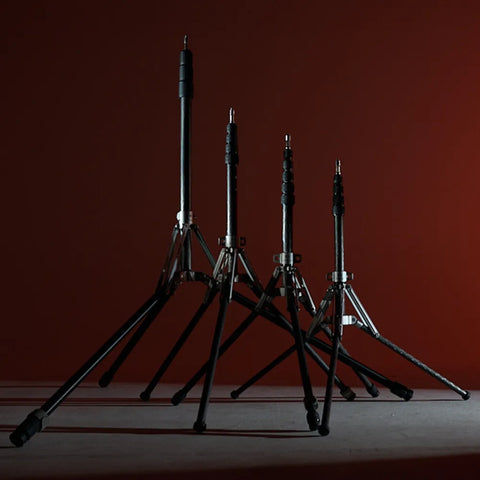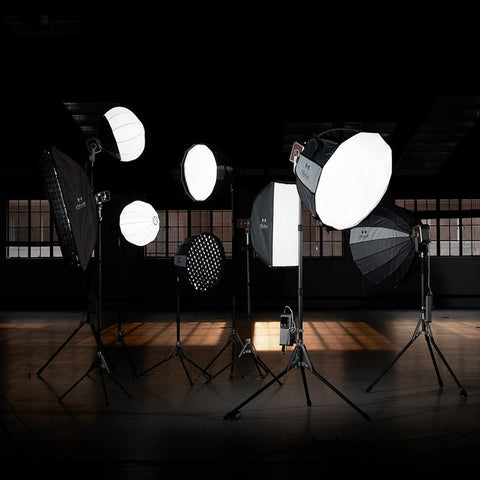Creating a home photography studio isn't about creating an elaborate space or a equipment-splurging collection of gear. Simplicity is what makes photography accessible to beginners and budget-minded hobbyists and challenges creativity by constraining it. By focusing on lighting and composition rules of photography rather than on equipment purchases, you can create professional-level photographs within the space of your own home.
Starting with Minimal Equipment
A common misconception among aspiring photographers is that achieving professional results requires an extensive collection of gear. In reality, quality photography stems from understanding fundamental principles, not from the volume of equipment. For beginners, starting with multifunctional studio lights like Harlowe lights can be particularly beneficial. Renowned for their versatility and excellent quality, Harlowe lights provide impressive results without the overwhelming complexity often associated with advanced lighting systems. They represent an ideal choice for photographers looking to keep their setups minimalist while still achieving great outcomes.
Recommended Items
What makes a home studio so wonderful is how little you'll have to have to get wonderful pictures. To begin taking wonderful photographs from home, here is what may help:
● A camera (even a smart phone with controls can accomplish)
● An adjustable tripod
● One or two multi-purpose studio lights
● A reflector (Do-It-Yourself white foam board if you like)
● A simple, tidy environment
These few basics allow you to master photography's three support pillars: subject, composition, and light. All the extras—additional studio lights, backdrop, and equipment—can then be added subsequently as your skill and needs dictate.
The Advantage of Starting Small
By beginning with just a couple of key lights, you allow yourself the flexibility to explore various lighting techniques without the clutter of multiple devices. This approach not only simplifies your workflow but also helps you focus on mastering essential aspects of light manipulation. When you're liberated from excess equipment, you can develop your technical skills in photography, making your work more creative and expressive.
Practicing Self-Portrait Photography
Self-portraiture offers a constantly available subject for practicing your studio techniques and is therefore a priceless method of practice for photographers of any experience level.
Growing Through Self-Portraits
The self-portrait process offers unique learning experiences. As photographer and subject, you experience both sides of the lens, learning how to pose well, the use of lighting for portraits, and direction. Getting both sides accelerates your learning regarding what does and doesn't work.
There are plenty of opportunities for frequent practice without the need to book models. You can experiment with anything on studio lighting setups, composition, and methods without limitation, building confidence before shooting with others.
Technical Approaches for Solo Sessions
Some methods enable self-portraiture:
● Remote controls or mobile apps to access your camera and lights
● Self-timers with multiple-shot capabilities
● Tethered shooting using a live view on a computer monitor
● The strategic use of mirrors to check composition before shooting
Position yourself first, using stand-ins or markers as reference points. Practice shoot, adjust accordingly, and move as quickly as possible between the camera and your position as the subject.
Learning from Results
The self-portrait critique loop is immediate and educational. Review your photos critically, assessing what was successful and what needs to change. Check portrait light quality, composition, natural pose, and technical implementation particularly.
Make note of your observations in a photography journal, mentioning particular settings and compositions that proved effective. This practice transforms aimless shooting into purposeful skill development.
Choosing the Right Wall
The foundation of your home studio begins with selecting an appropriate wall space that will serve as your primary shooting area.
Evaluating Potential Locations
When choosing your studio wall, consider these factors:
- Natural light availability and direction throughout the day
- Wall texture and existing color (smooth, neutral surfaces require less modification)
- Distance from the wall to allow for depth in compositions
- Ceiling height for overhead studio lighting options
- Proximity to electrical outlets
- Potential for privacy and minimal household traffic
The ideal wall receives indirect natural light that can be controlled with curtains or blinds, offering flexibility for different lighting scenarios.
Maximizing Limited Space
Among the common challenges in home-based studios is limited space. Even in small apartments, proper planning yields a functional space. Keep essential photography light equipment on rollers or in bin stacks that could be readily erected and stashed.
Design a system whereby your studio space could transform from studio to normal living space within a few minutes. This sort of flexibility makes regular practice a reality even in shared living conditions.
Working with Backgrounds
The background is often what separates amateur-looking photos from professional results, regardless of the subject matter.
Background Options for Different Needs
Backgrounds range from elaborate to elegantly simple:
- Paper rolls in various colors (gray and white are most versatile)
- Fabric backdrops like canvas, muslin, or velvet for different textures
- Collapsible backgrounds for quick setup and storage
- Thematic printed backdrops for specific shoots
Your choice should complement your typical subjects while allowing for creative variation. A neutral background with good texture often provides the most flexibility across different types of photography.
Creating Depth in Images
Flat, dull backgrounds produce flat, dull photos. Make depth visually by:
Position your subject at least 3-4 feet from the background to achieve separation. Use portrait lighting to achieve subtle gradients on the background rather than even illumination. Include minimal props or elements that suggest environment without detracting from the subject.
The spacing of elements in your frame plays an important role in the three-dimensional look of your photos, even in a small space.
DIY Background Alternatives
Innovative backgrounds do not have to be pricey. Here are some budget-friendly options:
Reuse bedsheets, drapes, or big pieces of fabric found in second-hand stores. Employ foam boards wrapped in contact paper or craft paper for smaller product photography. Try projected patterns from a small portable projector or even string lights behind transparent fabric.
These ad hoc solutions usually create unique looks that separate your work from others without breaking the bank.
Setting Up Your Photography Equipment
Strategic equipment arrangement maximizes both creative possibilities and workflow efficiency.
Creating an Efficient Layout
Your studio arrangement should prioritize:
Equipment accessibility when shooting alone Clear pathways for movement around your subject Protection of gear from accidental bumps or falls Adequate space for subjects to move naturally when photographed
Map your typical shooting patterns and organize gear accordingly, keeping frequently used items within arm's reach of your primary shooting position.
Managing Cables and Accessories
Nothing disrupts a creative flow like tangled cables or misplaced accessories. Implement a systematic approach:
Use hook-and-loop cable ties for quick bundling and release. Designate specific containers for small items like memory cards, batteries, and lens caps. Label everything clearly, including which cables belong to which devices in your studio lighting kit.
This organization prevents technical frustrations and extends the lifespan of your equipment through proper handling and storage.
Safety Considerations
A safe studio protects both people and equipment:
Secure softbox lighting stands with sandbags or weights to prevent tipping. Tape down cables that cross walkways to prevent tripping. Position equipment to avoid creating obstacles in the shooting space.
Regular safety checks before each session prevent accidents that could damage gear or cause injury, especially when working with models or clients in your space.
Combining Studio Lights with Natural Light
The integration of artificial light with available natural light creates distinctive, dimensional photographs that stand out. With Harlowe lights boasting a CRI rating of 96 and above, they are perfect for seamlessly blending artificial light with natural light, enhancing the overall quality of your images.
The Power of Hybrid Lighting
Mixed lighting approaches offer several advantages:
Natural light provides soft, complex illumination that's difficult to recreate artificially. Studio light adds controllable highlights and fill where needed. The combination allows for consistency regardless of weather or time of day.
This blended technique gives photographs a natural yet polished look.
Practical Mixed Lighting Techniques
To effectively combine light sources:
Position your subject where natural light creates pleasing basic illumination. Use softbox lighting to supplement, usually as rim or hair light rather than key light. Balance exposure carefully, typically exposing for natural light and adding artificial light as accent.
Practice measuring the relative intensity of your light sources with a light meter or through test shots to achieve consistent results.
Resolving Common Lighting Challenges
Mixed lighting introduces specific issues to manage:
Color temperature differences between natural and artificial light can cause unpleasant color casts. Harsh shadows from direct sunlight may conflict with your artificial lighting plan. Inconsistent natural light requires frequent adjustments during longer sessions.
With Harlowe’s bi-color accuracy, there’s no need to use color correction gels to match natural light temperatures. Instead, you can focus on using diffusers or reflectors to soften any problematic natural light patterns.
Creative Light Manipulation
Household items become valuable lighting tools with some creativity:
White foam boards make excellent reflectors for bouncing light. Sheer curtains or white bedsheets create effective diffusers. Aluminum foil on cardboard produces controllable reflected light for highlighting details.
These improvisations not only save money but also develop your understanding of how light behaves—knowledge that benefits all your future photography.
Safety Considerations
Lastly, a safe studio protects both people and equipment:
Secure softbox lighting stands with sandbags or weights to prevent tipping. Tape down cables that cross walkways to prevent tripping. Position equipment to avoid creating obstacles in the shooting space.
Regular safety checks before each session prevent accidents that could damage gear or cause injury, especially when working with models or clients in your space.
Transform Your Space into a Photography Studio Today!
In summary, building a minimalist home studio isn’t about amassing an arsenal of gear but mastering the fundamental principles of photography. Start small, invest in versatile equipment like Harlowe lights, and watch your skills flourish as you practice and experiment regularly. The most valuable investment is not in gear but in your dedication to improving your craft in your very own customized space!





